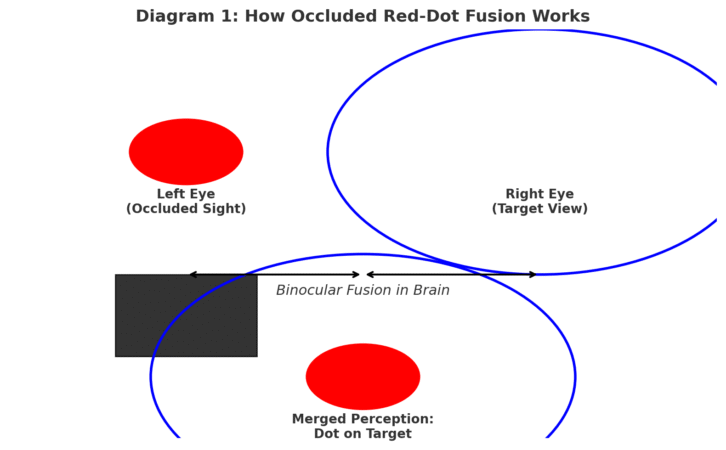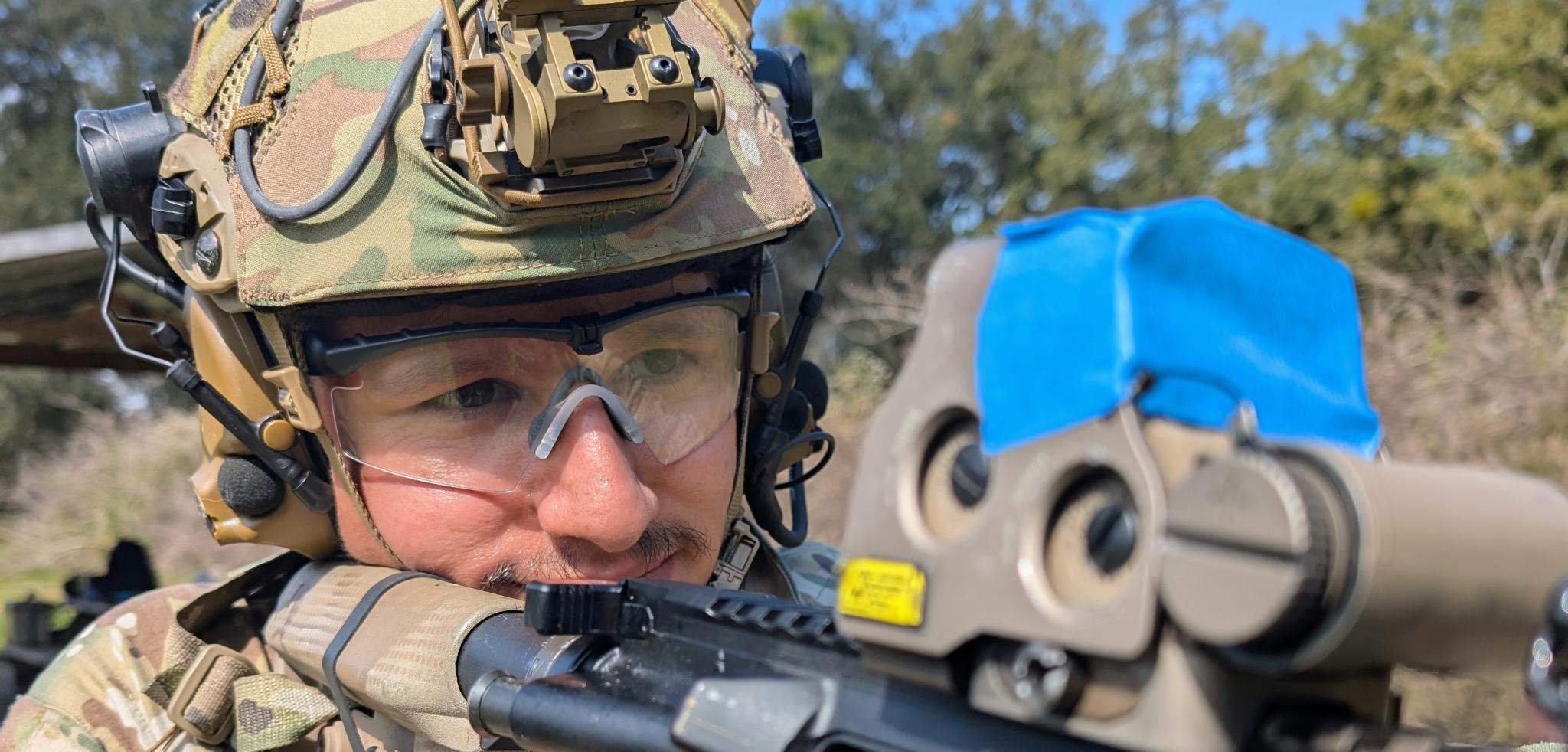The Science Behind Occluded Red-Dot Sights: How Your Brain Aims When Your Optic is Blocked
Introduction
In advanced firearms training, one counterintuitive method often surprises shooters: intentionally blocking the front lens of your red-dot sight during practice. Known as occluded red-dot training, this technique forces you to aim through an optic that—by all logic—should be useless.
Yet, when executed correctly, the dot still appears superimposed on your intended target. The result? Faster target acquisition, improved target focus, and enhanced performance under stress.
The reason this works is not magic—it’s neuroscience. By understanding how the human brain processes incomplete visual information, we can see why occlusion works and why it can make you a more effective shooter in real-world conditions.
1. How a Red-Dot Sight Works—and What Happens When It’s Occluded
A modern red-dot sight is a collimator: it projects a reticle (dot) at optical infinity so it appears aligned with the target regardless of your head or eye position. Normally, you see the dot and the target through the same lens.
When you block the front lens—using tape, a purpose-built cover, or even mud in a worst-case scenario—you remove the target image from that eye. However, the dot is still visible because it’s reflected inside the optic and entering your shooting eye.
Now comes the trick: when you shoot with both eyes open, the unobstructed eye sees the target clearly, while the “occluded” eye still perceives the dot. Your brain merges both images into a single, seamless view.
This is possible because of binocular vision and neural image fusion, the same mechanism that allows you to see one unified world despite having two slightly different eye inputs.
2. The Neuroscience: How the Brain Creates Reality From Fragments
The human visual system is not a video camera—it’s a reconstruction engine. As neuroscientist Heather Berlin explains, your brain throws away most of the raw data it receives and builds a working “simulation” of the world using only a small fraction of real input.
Key scientific principles at play:
- Binocular Fusion – The visual cortex combines separate inputs from each eye into a unified perception. If one eye sees a target and the other sees a dot, the brain overlays them.
- Perceptual Fill-In – Similar to how your brain fills in your natural blind spot, it fills missing visual data with the most likely match based on context and memory.
- Predictive Processing – The brain is constantly guessing what should be there, based on prior experience, and then updating that guess with new input.
As Dr. Stephen Macknik notes, you only see fine detail in a tiny portion—about one degree—of your visual field at any given time. Everything else, including much of your peripheral image, is a mental reconstruction. This explains why, with an occluded optic, your brain has no problem “placing” the dot onto the target even if your aiming eye doesn’t see the target through the optic at all.

Diagram showing how the brain merges the occluded dot image from one eye with the target image from the other, producing a unified perception of “dot on target.”
3. Why This Works Under Stress and Adrenaline
In a lethal-force encounter, adrenaline changes everything:
- Your field of vision narrows (tunnel vision).
- Your fine motor control deteriorates.
- Your brain defaults to trained, subconscious behaviors rather than conscious aiming steps.
Training with an occluded sight forces you to trust your natural visual processing instead of over-focusing on aligning a crisp dot. The brain learns to maintain target fixation while still registering the aiming reference in peripheral awareness.
When you then use an unobstructed optic in real life, your ability to see the target first and let the dot find it becomes instinctive—critical when milliseconds decide survival.
4. Benefits of Occluded Red-Dot Training
a) Builds Target-First Visual Habits
New shooters with red dots often make the mistake of “chasing the dot,” slowing down their engagements. Occlusion breaks this habit by forcing the eyes to stay on the target.
b) Faster Transitions
When moving between multiple targets, a target-first approach reduces micro-delays caused by shifting focus between dot and target.
c) Stress-Resilient Aiming
Because the technique leans on subconscious perception, it survives adrenaline effects better than a purely mechanical aiming process.
d) Contingency Preparedness
In the real world, optics can fog, smear, crack, or be partially blocked. Occlusion training ensures you can still fight effectively if your sight’s front lens is compromised.
5. The Science Applied: Why the Dot Stays “There”
Think of your brain as a mission control center with two high-resolution cameras (your eyes) feeding in separate images. Even if one camera’s feed is partially blocked, the processing software (your brain) combines the remaining usable data into a working picture.
This is also why red-dot sights are inherently parallax-free—the reticle is designed to remain on target regardless of head position. When occluded, your brain simply continues to treat the dot’s position as fixed relative to your target because it has no conflicting data telling it otherwise.
6. Training Methodology
If you want to integrate occlusion training:
- Cover the front of your optic with opaque tape or a lens cover.
- Keep both eyes open—this is critical. Closing one eye defeats the effect.
- Engage from various distances to build confidence in the overlay effect.
- Incorporate movement and stress drills to simulate real-world adrenaline responses.
- Alternate between occluded and clear sessions so your brain can link both experiences.
Conclusion
Occluded red-dot training is more than a range trick—it’s a neuroscience-driven skill builder. By harnessing your brain’s natural ability to merge fragmented visual data into a single, actionable picture, you develop a target-first engagement style that’s faster, more intuitive, and more resilient under pressure.
The technique exploits the same mental shortcuts that let you navigate the world despite blind spots and limited high-resolution vision. In a fight, those shortcuts can be the difference between hesitation and decisive action.
At Valortec, we teach this not as a gimmick, but as a combat-relevant tool—one that conditions the shooter’s mind and body to perform when it matters most.






